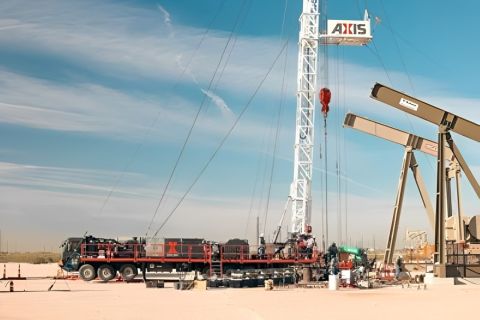Presented by:
[Editor's note: A version of this story appears in the April 2021 issue of Oil and Gas Investor magazine. Subscribe to the magazine here.]
 Coleman Rowland
Coleman Rowland
Managing Director, Enterprise Risk Solutions
BKD
Coleman Rowland is a managing director in BKD’s Enterprise Risk Solutions division and serves as the national consulting leader for energy and natural resources. His client service experience includes leading large-scale transformation initiatives, optimizing financial management processes in complex, global business environments and assisting clients in solving complex business problems in domestic and global markets. He has more than 30 years’ experience working with power utility and upstream, midstream and downstream energy companies’ operations and financial systems.
 Gerrad Heep
Gerrad Heep
National Partner In Charge of Energy – Audit
Grant Thornton
Gerrad Heep has more than 14 years of experience serving private and publicly traded corporations and partnerships in the energy industry, including natural gas pipelines and storage, exploration and production, trading and marketing, chemical manufacturing and refining, oilfield services and seismic acquisition. He has advised clients on equity and debt offerings for publicly traded energy companies and due diligence projects relating to various M&A within the energy industry.
 Brian Baumler
Brian Baumler
Director, Audit
PKF Texas
Brian Baumler is an audit director and energy practice leader with PKF Texas and provides audit services to both public (SEC) and private businesses focusing on energy and energy-related businesses. His professional experience includes more than 30 years of public accounting experience in GAAP and SEC reporting with an in-depth knowledge of the oil and gas industry focusing on upstream businesses such as exploration and production, oilfield services, seismic and equipment manufacturers.
 Daron Fredrickson
Daron Fredrickson
Partner
Merit Advisors
Daron Fredrickson is a partner with Merit Advisors in Houston with 30 years of experience in the tax industry. Prior to joining Merit, he was the director of indirect tax at Chesapeake Energy Corp. and has spent more than 15 years as a consultant and a decade in the corporate world. Daron has received the Distinguished Service Award from both the Oklahoma Oil & Gas Association (OKOGA) and the Louisiana Oil & Gas Association (LOGA). He currently serves on the board of LOGA and is chairman of its tax committee. Daron is co-chair of the OKOGA Ad Valorem Tax Committee, and a member of the Texas Oil & Gas Association Minerals Subcommittee for Ad Valorem Tax.
Investor: What are the risks that private energy companies face when targeted by a special purpose acquisition company, or SPAC? What do they need to be prepared for once they are acquired and de-SPAC’ed as a new public company?
Heep: If the target company is not properly equipped to be a public company that could be a risk. For example, the company may not have the personnel to conduct the kinds of activities a private company could previously defer—e.g., segregating duties, tackling complex transactions and adopting new accounting standards. It is not uncommon for newly public companies to disclose material weaknesses in internal controls, which can be a big change for them.
Another risk is that the target company auditor is not independent under the more restrictive independence rules spelled out by the Securities and Exchange Commission (SEC) and the Public Company Accounting Oversight Board. This means that the target company might need to change its auditor and perform complete re-audits.
Fredrickson: From our standpoint, the anticipated high-growth rate of these new companies creates challenges for establishing scalable state and local tax capabilities that can result in over-taxation or tax exposure. We have seen several high-growth companies over the years pay hundreds of millions of tax unnecessarily because they didn’t have a good understanding on the requirements of the state and local tax code. Making sure you have a good technology, teams and partners to scale in all business functions as a high-growth public company is essential to share-price appreciation.
Rowland: One key thing to prepare for is getting their accounting and financial reporting function “SEC ready.” The first step is to perform a “gap analysis” to identify the initiatives necessary to move the company toward the ability to create a timely and accurate financial statement in the eyes of the SEC.
Investor: What is the impact of the move to using carbon credits, and what will it mean to the financial stability of these companies individually and the industry collectively?
Baumler: The reduction of emissions and decarbonization is a growing commitment of the energy industry and providing carbon credits for carbon offset projects is a way of financing this initiative. Without carbon credits many projects would not be economical so they become critical to their viability and drive investor interest.
“We have seen several high-growth companies over the years pay hundreds of millions of tax unnecessarily because they didn’t have a good understanding on the requirements of the state and local tax code.”
—Daron Fredrickson, Merit Advisors
Ultimately, carbon credits/offsets are acquired by companies that generate excess unavoidable greenhouse gases so it’s a way for the energy industry to take responsibility for their emissions and partially finance green projects. It further supports ESG [environmental, social and governance] initiatives with the majority of energy companies feeling a lot of pressure to support renewable energy, sustainability and energy transition with the upstream sector facing the most scrutiny for its impact on the environment.
Thus, this growing trend has moved most energy companies to adopt ESG as a component of corporate policy and strategy since it greatly influences investors’ perception of winners and losers and demonstrates the industry’s commitment toward sustainability.
Fredrickson: The primary change we are already seeing is the calculation of the companies to reduce their net carbon footprint. The challenge will be to do that and find a way for it to add to the revenue stream in some manner. If added as pure expense, profitability is most likely not attainable. Carbon capture, with delivery into a pipeline or market of some type, seems to be the vehicle of choice so far. In addition, we are seeing oil and gas companies, directly or indirectly, plan to add renewables to their portfolios. This addition is to make them as carbon neutral as possible.
The capital expenditures on these projects are significant and can add substantial state and local tax liability to companies. These can be offset somewhat with tax incentives or abatements, which we prepare often for clients.
Investor: Oil prices have risen from the bottom since last year to above $60 recently, but the forward curve remains backwardated. What is the impact of this on the valuation of oil and gas reserves, and how do you treat it from an accounting position? Can you “write-up” reserves after writing them down when prices are low?
Fredrickson: The one constant in the oil market is volatility. Volatility is based on supply/ demand fundamentals, but also significantly more on sentiment. Currently, in our client base, we see oil and gas producers all over the spectrum as to how to react in this market. Reserve calculations are based on forward looking assumptions. In what we do, for property tax purposes, the valuations are based on assumptions at a specific snapshot in time. The key is to make sure the property tax value is reflective of actual fair market value of the underlying hydrocarbons at that point in time. Often times we find property tax values to be inflated, which can create a drag on well economics as the owners are now paying higher ad valorem taxes.
Rowland: We see three time horizons and related key questions working themselves out through the price of oil and the forward curve:
- Post-COVID-19/vaccine time horizon (now) – When will this normalize?
- Economy opening up/economic rebound (12 to 18 months) – How strong will the economic recovery be?
- Move away from hydrocarbons (15 to 20 years out) – At what pace will the transition occur?
With respect to the valuation of reserves, it depends how they are carried on the balance sheet. If the reserves are reported as PV10 or fair value, they can fluctuate in value based on price curves. If the reserves are part of an asset group and tested for impairment as such, it is likely a write-down.
Baumler: Property valuations take into consideration a point in time forward price curve when evaluating estimates of fair value which means forward prices today will not be the same prices tomorrow and will not be the future prices on such dates upon delivery when you ultimately get there. Forward prices may follow a recent upward trend in volatility driven by supply/demand dynamics; however, as months extend out into the future there is a downside bias until the market moves back into balance thus creating backwardation.
For successful efforts, company’s year-end valuations of underlying reserves are used as a basis in determining if there are impairments of oil and gas properties. An impairment is determined as of a point in time and fair value assumptions, under U.S. Generally Accepted Accounting Principles, do not allow for you to take into consideration near-term recovery of prices on a look-back basis. When an impairment is required to be taken it is permanent and cannot be reversed in future periods despite a recovery in prices, which seems counterintuitive to estimation assumptions.
 Heep: U.S. Generally Accepted Accounting Practices do not allow a company to “write-up” its mineral property balance after impairment. However, an oil and gas company following International Financial Reporting Standards allows this write-up, but no further than the original cost basis.
Heep: U.S. Generally Accepted Accounting Practices do not allow a company to “write-up” its mineral property balance after impairment. However, an oil and gas company following International Financial Reporting Standards allows this write-up, but no further than the original cost basis.
Investor: With so many energy firms shedding head count or working remotely during the pandemic-driven downturn last year, has this created challenges—or weaknesses—in your clients’ overall business processes and internal control structures? What are the issues, and what can they do to address them?
Rowland: These groups are being asked to do the same—or more—work with fewer people. This is a good time to look at driving standardization and automation in the back office. Close automation tools have become affordable and relatively easy to implement. Robotic process automation has also become very popular. These are just two good examples of how to manage the challenge of reduced headcount.
Heep: Our clients have been pleasantly surprised by the ability of their people to work in leaner, more remote environments. Whether it be employees in the field, reserve engineers or accounting and finance staff, people have adapted quickly. One challenge I think any industry faces is how to implement and monitor your company’s culture in the remote environment. I don’t know the best way to address this, but I do think the increased focus on ESG came at a great time as it relates to sustaining a strong culture.
Baumler: As markets push downward and such trend is other than temporary, companies quickly respond by initiating cost-cutting programs with human capital generally at risk in areas that do not support growth of the business. Despite my bias that accounting departments are profit centers within an organization, that is not always the view when evaluating where costs can be trimmed.
Relieving headcount in areas where key process controls exist oftentimes results in weaknesses that could lead to misstatements in data used in day-to-day operations and, ultimately, internal and external financial reporting. Management of the company uses this information on a day-to-day basis to make business decisions and third-party external users of the financial statements also use them to make investment choices.
 To address these concerns there are a couple of choices to consider. Look at systems and processes and assess where process automation would eliminate the need for a person who used to perform repeatable day-to-day tasks. Many companies choose to remain in primitive manual process or low-use technology structures which are oftentimes riddled with human error. Process automation and digital transformation have big benefits generating consistency and reliability in information, saves time, operational efficiency and ultimately reduces cost.
To address these concerns there are a couple of choices to consider. Look at systems and processes and assess where process automation would eliminate the need for a person who used to perform repeatable day-to-day tasks. Many companies choose to remain in primitive manual process or low-use technology structures which are oftentimes riddled with human error. Process automation and digital transformation have big benefits generating consistency and reliability in information, saves time, operational efficiency and ultimately reduces cost.
Fredrickson: Unfortunately, we have seen the job losses from the significant reduction in G&A across the industry. As a result, we have seen mass outsourcing. The outsourcing we have been involved with has primarily been in the property tax and sales tax areas. The property tax area, specifically, is still very paper driven and requires physical presence for many of the functions. Utilizing technology, our firm has developed capabilities to take on single functions or entire state and local tax departments as needed by our clients with a seamless integration into our clients’ day to day.
Investor: The harsh downturn last year resulted in an exodus of experienced technical and operational talent from the oil and gas space. Will this talent be replaced when the economic environment turns around, and where will it come from? How much can technology actually replace people?
Baumler: It seems that downturns in the energy industry in the past 20 years have become more frequent and longer in duration with each occurrence. With that, the highly experienced workforce has become concerned about their personal livelihood and hopes of building a nest egg as they near retirement. It has become commonplace that as they become displaced, it is becoming harder and harder to lure them back into the workforce over being gainfully employed elsewhere with less volatility.
I have always taken great pride in serving clients in the energy industry and enjoy the closely-knit energy industry community which makes a big city like Houston feel pretty small. Things have obviously changed and recruiting new talent has its challenges since the energy industry is not in favor due to its image. There is a need to bridge the gap between capabilities and skills. So, with the industry facing workforce challenges, what can they do to overcome this skills crunch?
If the workforce is not returning, consider automation of tasks where appropriate. Automation and digitation of data can eliminate the need for resources performing tasks that provide less operational value with the benefit of improved quality and consistency. Automation works great for repetitive tasks, but does not replace experience and judgment.
The other thing to do is upskill the workforce. Upskilling, not reskilling, retains existing employees, experience and knowledge of the organization and provides opportunities for growth, professional development and introductions to new technologies. The benefits to the organization are that it bridges the knowledge gaps, boosts employee overall satisfaction, moral and motivation which in turn provides an attractive platform for retention and helps an organization be competitive in recruiting top talent.
Rowland: We see the oil and gas sector facing challenges in replacing the technical and operational talent that is exiting. Artificial intelligence, machine learning and robotic process automation certainly can play a role in bridging the talent gap, but the sector will likely fall short.
Fredrickson: We have in fact seen the exodus mentioned to some degree. That said, we have seen diligent companies find ways to keep their best young talent and high grade their positions in the market. The industry has been and continues to be blessed with a lot of talented teams and individuals. As we have grown throughout this downturn, we have been very fortunate to pick up talent along the way.
Nonetheless, the environment has created structural challenges, but it is incumbent upon the industry to continue to find ways to work smarter so the commodity price volatility doesn’t turn into talent- recruiting volatility.
Technology does not necessarily replace good people, but it makes good people more efficient. A higher standard of efficiency should lend towards less volatility on the talent side in the future.
“The reduction of emissions and decarbonization is a growing commitment of the energy industry and providing carbon credits for carbon offset projects is a way of financing this initiative. Without carbon credits many projects would not be economical so they become critical to their viability and drive investor interest.”
—Brian Baumler, PKF Texas
Investor: How has your firm responded to being able to serve your clients effectively and efficiently during an era of remote operations and virtual environments?
Heep: It starts with showing understanding and empathy to each client situation and then adjusting appropriately. We have clients that will allow a full team to come out to their offices, while other clients still will not allow vendors to be on site. In the latter situation, we found creative and agile solutions, including site visits and inventory observations using FaceTime, and process and control verification through live PC sharing. We also rolled out new offerings to help our clients manage the disruption and uncertainty of COVID-19—most notably a pandemic risk-assessment tool.
Fredrickson: Luckily, we have been a technology focused-firm and have had the resources to work remotely and virtually, so other than more virtual calls and less in-person meetings, not much has changed. Our results for our clients were better than ever before in the last year.
Rowland: Serving clients remotely was a daunting challenge at first, but it’s been truly amazing what we’ve been able to do in a work-from-home world. A key takeaway from this experience: For our junior professionals, the learning and mentoring that occurs when the first-year audit or tax staff is sitting in the same room as the in-charge or senior cannot be replicated using remote tools. Also, from a marketing and business development standpoint, no other medium of interaction can replace good old face-to-face meetings, lunches, etc.
Baumler: Here at PKF Texas, technology has been key to allow us to continue working effectively with our clients during the pandemic. We had already implemented the Microsoft Teams software and were beginning to experiment through Zoom in advance of the pandemic, so that gave us a leg up on connectivity with our team members.
Keeping quality professionals has been a challenge for the CPA profession for as long I can remember. When life choices present themselves what we have tried to do is eliminate the option of exiting the firm to be the only option that would allow for life responsibilities and goals to be met. We have employees of the firm working in other states which we were able to achieve through the use of technology. This allows our best talent to remain within the firm, working from anywhere effectively overseeing the work of our engagement teams, while continuing to be responsive to our client’s needs and expectations.
The pandemic event devastated a number of companies and negatively impacted the majority of industries in one way or another. Being forced to work in a remote environment caught many companies off guard and scrambling to stay connected to the office, their teams, their operations as well as their customers and clients. Since we had made substantial investments in a virtual/remote infrastructure the impact of the pandemic was for the most part a nonevent and was well planned for.
However, what we were less prepared for was adapting to some of the challenges our clients faced. Some clients encountered suspended operations, lack of effective technology and managing the safety of their workforce which changed their priorities. We did observe that shifting to a 100% remote service delivery has its inefficiencies and is clearly not as good as being shoulder-to-shoulder with our clients.
On-the-job training for new professionals required continuous touch points throughout the day making the learning experience not as effective nor as convenient as being in the same room together. As we all know, time is money in our profession, so more time means that realizations were squeezed as more time was required in the exchange of data and responses to inquiries as they arose.
So after almost a year of working remotely serving clients, growing our professionals and managing the operations of our firm, what did we learn? To start with, we are all in the same boat and to think that work will return to the same level of in-office interaction is less likely, since there is a growing level of acceptance of the remote work solution. We have become more efficient in how we interact with engagement teams through virtual team rooms and chats. It’s still not quite the same as sitting in the same room together, but it certainly has become more efficient over time. Where we are today is where we would have been five years from now, so in reflection what took place in 2020 it was merely a crash course on readiness for what was coming.
“For the most part, I have yet to see the ability to raise capital negatively impacted by a perceived lack of ESG focus. ... That said, my clients are taking ESG very seriously.”
—Gerrad Heep, Grant Thornton
Investor: What impact will the push for an energy transition away from hydrocarbons have on your clients and could it cause significant impairments, write-downs or divestitures in certain areas of these companies?
Baumler: Decarbonization trends are putting pressure on upstream oil and gas companies to shift their focus to low carbon business models. How they choose to embrace energy transition may determine how they are viewed by the investors and the overall general public.
Shell recently announced that its daily production peaked in 2019, and it’s now predicted it to gradually decline 1% to 2% per year as they embark on their desire to shift to greener energy stating that its oil and gas will pay the way toward transformation. Other majors have echoed similar statements regarding peak production and their plans to focus on green energy.
I believe in the near term the impact of energy transition will not be that noticeable since it will take several years and even decades to move the transformation needle globally. Demand for oil and gas will remain in place as long as the transportation industry leans on traditional hydrocarbon-based fuels which for now is the lowest-cost fuel source available.
I can foresee divestitures occurring to the extent companies choose to honor their commitment to embrace low carbon initiatives but to the extent of the oil and gas that has been discovered it will be produced into the future until other forms of low/no emissions energy resources are cost effectively brought to market. Ultimately, returns to shareholders will determine the speed of energy transition.
Fredrickson: As with any transition, it will happen over time and companies will adapt. The portfolios of companies will transition and be more diverse. Our focus is on helping our clients reduce cost and transition smoothly. Given that the market value of our client’s assets will decline significantly in this transition, it is essential for us to make sure their property tax values and ad valorem taxes are reflective of the value lost in the transition. For the new asset-base to replace hydrocarbons, we partner with our clients on the front end to lower their state and local tax burden tied to these assets, enhancing the returns of those projects.
Heep: We are already seeing the impact on some larger integrated companies like Exxon, which has announced plans to invest in more low carbon solutions. Many of our clients, whether they are upstream or midstream, realize that there cannot be a dramatic, immediate shift away from fossil fuels.
As we saw in 2020, many factors can significantly affect the price of a barrel. Even with the current administration’s focus on energy transition, the demand for oil and gas will still be there, and the focus of the administration alone does not have a direct relationship with impairments. We are carefully monitoring how supply is managed.
Rowland: Most industry players recognized significant impairment during 2020, so the bad news is likely behind them. Similar to the three time horizons articulated in the earlier, there is likely little immediate impact. There will certainly be a move in this direction in the next 15 to 20 years or more.
Investor: How would a federal lands drilling ban affect the accounting and financial reporting for oil and gas operators?
Fredrickson: The immediate impact from the actions already seen has been the increased risk profile being recognized by companies. For companies with a significant number of permits in place, especially those with years of backlog ready for drilling sites, the impact is not as significant. For companies with drilling programs just beginning or those with pending permits, those projects will be written down or possibly abandoned completely. While these assets lose their market value, it’s important to make sure their state and local tax burden is reflected.
 Baumler: Federal leases account for approximately 10% of production so—to the extent there is a drilling ban—obviously would have a near-term impact on oil and gas companies who hold concentrations of federal leases with undeveloped acreage positions. The moratorium halts only new leases, therefore permits in place will have the opportunity to be developed with large producers having substantial inventories of drill-ready permits in place.
Baumler: Federal leases account for approximately 10% of production so—to the extent there is a drilling ban—obviously would have a near-term impact on oil and gas companies who hold concentrations of federal leases with undeveloped acreage positions. The moratorium halts only new leases, therefore permits in place will have the opportunity to be developed with large producers having substantial inventories of drill-ready permits in place.
Depending on the level of concentration the impact could be material to any one individual company and will have a disproportionate effect on certain states that have concentrations of federal land used for oil and gas producing activities such as Colorado, Montana and New Mexico.
The impact to oil and gas companies could be potential impairments of proved and unevaluated properties resulting from the derecognition of reserves that would have originally been classified as PUDs that may no longer meet the SEC definition of reserves due to the lack of potential for development as well as acreage positions which would ultimately expire if not held by production. Further to this, a large loss of jobs would occur concentrated in areas or states with a large concentration of federal leases used for oil and gas producing activities.
Heep: There would likely be greater impact on reporting than accounting, as the accounting largely follows the assets that are already drilled or owned. We have already seen companies update their risk factors to address accounting issues. Companies whose strategy is to replace reserves by drilling on federal land, will have to continue to monitor and update disclosures accordingly.
Rowland: It’s really an economic question as much as an accounting question. Overall, the drilling ban will fuel a long-term reduction of supply. If upstream companies are involved in federal lands, they may be forced to seek out higher-cost alternatives, which could affect profitability, financing and liquidity.
Investor: As capital providers are favoring oil and gas companies in compliance with ESG principles, how are you advising clients to be responsive to the ESG mandate? Is this affecting your clients and their viability to raising capital? Do you see this as a financial risk, and how are they addressing it? Should companies divert capital into green initiatives for ESG purposes but that may not be profitable? Do small companies have the bandwidth to implement ESG protocols?
Rowland: Many point to Larry Fink’s 2020 CEO letter as the indication that ESG is here to stay. We are advising clients to view ESG reporting not as a burden, but an opportunity to drive enterprise value and mitigate risk.
To help our clients get started building their ESG program, we use a four-phase approach: Assess, Design, Implement and Monitor. During the Assess phase, it’s critical to engage with the investment community to understand how they are integrating ESG concerns into their investment decisions. Down the road, we see the possibility of accounting firms providing an attestation on the ESG report, similar to financial statement audits.
We are seeing larger companies hiring ESG leaders and using outside advisors to assist with building out their ESG program, and smaller companies have more of a tendency to outsource/hire consultants.
“These groups are being asked to do the same—or more— work with fewer people. This is a good time to look at driving standardization and automation in the back office. Close automation tools have become affordable and relatively easy to implement.”
—Coleman Rowland, BKD
Fredrickson: We are working with clients and industry trade associations to help mitigate the cost and tax liability associated with the mandates. Inherently, adding costs to an investment lowers the returns, but our job is to help our clients offset that cost through state and local credits and incentives. Many investors are only interested in investing in the companies who have a portfolio that includes renewable energy or carbon capture projects, but they still have to generate an acceptable return. Small companies will have to be more select in how they fulfill the investor-mandated ESG principles as they have fewer resources, but will still be beholden to the investors return mandate.
Heep: For the most part, I have yet to see the ability to raise capital negatively impacted by a perceived lack of ESG focus. While it may be happening to some degree, I think it’s limited. That said, my clients are taking ESG very seriously, having been involved in several conversations on strengthening and reporting their existing and targeted ESG program. The demand for consulting on this initiative is so great that we have formed a client service team dedicated to all things ESG.
Baumler: I work with primarily small-cap and middle-market companies that operate on very tight cash flows so it’s difficult for many to support an ESG strategy that requires substantial financial resources. For that reason, investments in green initiatives for ESG purposes is not practical without a profit motivation or least a return of investment.
However, it does not mean you do nothing as the investment community, and the general public expect energy industry companies to be thinking about these initiatives and how they plan to evolve and participate in the future. Since energy companies fall into a common energy industry basket it would be important to at least understand how the energy industry is responding to green initiatives and be able to communicate this for the benefit of cleaning up the market perception of the industry.
Substantial amounts of capital are invested in the form of R&D by the majors seeking improvements in emissions and protecting the environment with a focus toward eventually being emissions neutral. Some things come from innovations in technologies and others through directives creating awareness and change toward consumers on how they use energy. The energy industry is already hypersensitive to the needs of the environment but despite all this effort it seems to fall on deaf ears with very little credit given toward the industry’s commitment to environmental responsibility.
 When it comes to raising capital it’s apparent from the numerous articles out there on this topic, and discussions I have had with investment bankers and fund managers, that the investor community supports companies who have in place or are evolving their ESG strategy. It does not mean that capital is not available to companies to continue development of traditional energy assets that may not be as advanced in their ESG focus.
When it comes to raising capital it’s apparent from the numerous articles out there on this topic, and discussions I have had with investment bankers and fund managers, that the investor community supports companies who have in place or are evolving their ESG strategy. It does not mean that capital is not available to companies to continue development of traditional energy assets that may not be as advanced in their ESG focus.
It’s the continued development of existing assets that will eventually fund the energy industry transition to renewables and green energy initiatives. The growing awareness and concerns toward the impact that fossil fuel development and related emissions have on the environment increases investor desire to screen and align their investment interest with personal and social values. Those companies who have in place an ESG strategy have a leg up on those that don’t; however, investor returns still play into how capital eventually reaches those that know how to effectively deploy resources for long-term value creation.
Lastly, the “G” in ESG, which is governance, I think has a significant impact on a company’s ability to raise capital. However, it is oftentimes overshadowed by considerations over climate risk. Governance is the driver for sustainability and with it comes fiduciary duties and responsibilities of the board of directors and officers of the organization.
Governance can be rather complex as it covers a lot of areas but, through the lens of sustainability, comes oversight and responsibilities for policymaking, risk management, code and values, systems, transparency and ultimately reporting. Governance creates a framework for how corporations are directed and controlled, objectives are set and how performance is monitored. Without a strong tone from the top and commitment toward governance and accountability to its stakeholders, organizations often lose confidence from those expecting them to outperform over the long run. When it comes to ESG, governance is key to attracting investor interest and those wanting to own a company and not just renting it for the short run.
Recommended Reading
AI Poised to Break Out of its Oilfield Niche
2024-04-11 - At the AI in Oil & Gas Conference in Houston, experts talked up the benefits artificial intelligence can provide to the downstream, midstream and upstream sectors, while assuring the audience humans will still run the show.
Going with the Flow: Universities, Operators Team on Flow Assurance Research
2024-03-05 - From Icy Waterfloods to Gas Lift Slugs, operators and researchers at Texas Tech University and the Colorado School of Mines are finding ways to optimize flow assurance, reduce costs and improve wells.
Defeating the ‘Four Horseman’ of Flow Assurance
2024-04-18 - Service companies combine processes and techniques to mitigate the impact of paraffin, asphaltenes, hydrates and scale on production — and keep the cash flowing.
Axis Energy Deploys Fully Electric Well Service Rig
2024-03-13 - Axis Energy Services’ EPIC RIG has the ability to run on grid power for reduced emissions and increased fuel flexibility.
StimStixx, Hunting Titan Partner on Well Perforation, Acidizing
2024-02-07 - The strategic partnership between StimStixx Technologies and Hunting Titan will increase well treatments and reduce costs, the companies said.






